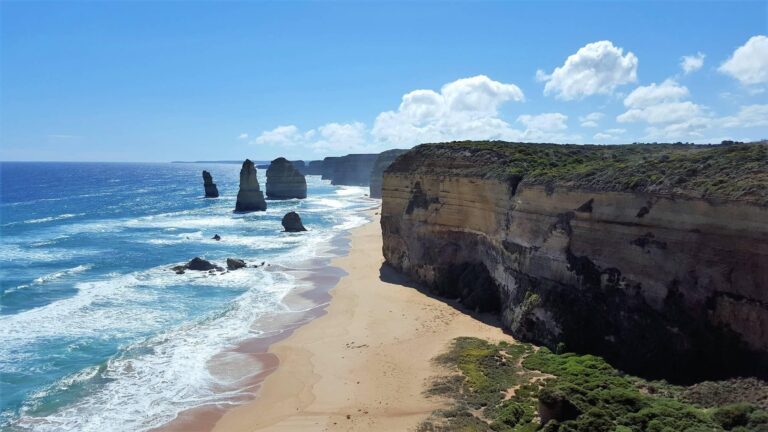Australia’s south-east coastlines are once again facing significant challenges as strong winds and large waves batter the region, compounding ongoing environmental and coastal management issues. The latest bout of harsh weather has raised concerns among local communities, authorities, and environmental experts about the increasing frequency and severity of such events, highlighting the urgent need for resilient infrastructure and adaptive strategies. This continuing pattern underscores the vulnerability of Australia’s coastal ecosystems and settlements to the growing impacts of climate change.
South East Coastlines Face Renewed Threats from Severe Weather Conditions
The south-east coastlines of Australia are once again under siege as relentless strong winds and towering waves batter the shorelines, exacerbating already fragile coastal environments. Communities from New South Wales to Victoria are grappling with ongoing erosion, damaged infrastructure, and increased flooding risks. Recent meteorological reports highlight a series of deep low-pressure systems moving across the Tasman Sea, intensifying sea conditions and raising alarms among local authorities and residents alike.
Experts warn that the confluence of climate change and natural weather variability is contributing to a pattern of more frequent and severe coastal events. Authorities have urged preparedness, pointing to key affected areas:
- Coastal erosion hotspots requiring urgent reinforcement
- Communities at heightened risk of flooding
- Critical infrastructure vulnerable to wave damage
| Location | Wave Height (m) | Wind Speed (km/h) | Damage Level |
|---|---|---|---|
| Gippsland | 5.3 | 85 | Moderate |
| Illawarra Coast | 6.1 | 90 | Severe |
| South Coast NSW | 4.8 | 80 | Moderate |
Environmental Impact and Community Challenges Amid Persistent Coastal Damage
The ongoing bombardment of Australia’s south-east coast by relentless winds and towering waves is taking a severe toll on both the natural environment and local communities. Coastal ecosystems, including fragile dune systems and wetlands, are suffering accelerated erosion, threatening native flora and fauna that depend on these habitats. Marine life is also at risk, with disrupted breeding grounds and increased sedimentation affecting water quality and biodiversity. Residents and environmental experts alike warn that without urgent intervention, the damage could become irreversible, leading to a permanent shift in the region’s ecological balance.
Communities along the coast face growing challenges beyond environmental loss. Frequent flooding and infrastructure damage are disrupting daily life and exacerbating economic pressures, particularly for small businesses and tourism operators reliant on a stable coastline. Emergency services are stretched thin responding to crises, while local governments struggle to secure funding for long-term mitigation projects. Key concerns include:
- Increased property damage due to coastal erosion and storm surges
- Displacement risks for vulnerable populations in flood-prone areas
- Limitations on coastal access impacting recreational and commercial activities
- Costly repairs and infrastructure reinforcement straining municipal budgets
| Impact | Affected Area | Community Response |
|---|---|---|
| Dune System Loss | Jervis Bay | Voluntary planting programs |
| Beachfront Flooding | Batemans Bay | Temporary sea walls installation |
| Erosion of Fishing Grounds | Merimbula | Fishing quotas review |
Experts Urge Strengthened Coastal Defenses and Enhanced Emergency Preparedness
Specialists in coastal management and climate resilience are calling for urgent action to safeguard Australia’s vulnerable south-east coastlines. Recent events have highlighted the stark reality that current defenses are struggling to withstand the increasingly frequent onslaught of powerful winds and towering waves. Experts emphasize the need for comprehensive infrastructure upgrades, including reinforced seawalls and natural buffer zones such as restored dunes and mangroves, to reduce erosion and mitigate the impact of storm surges.
Alongside physical defenses, enhanced community emergency preparedness is deemed crucial. Recommendations include:
- Expanded early warning systems to alert residents well before extreme weather hits
- Community education programs focused on evacuation plans and hazard awareness
- Investment in rapid response teams equipped for immediate post-storm relief
| Measure | Expected Benefit | Implementation Timeline |
|---|---|---|
| Seawall reinforcement | Reduced erosion and flood risk | 2-3 years |
| Natural buffer restoration | Improved habitat and storm absorption | 3-5 years |
| Community drills & education | Faster evacuation and fewer injuries | Ongoing |
The Way Forward
As Australia’s south-east coastlines continue to grapple with relentless strong winds and large waves, the challenges facing the region remain acute. Communities and authorities are urged to remain vigilant as recovery and mitigation efforts press on, highlighting the urgent need for long-term strategies to address the escalating risks posed by climate change and coastal erosion. With no immediate reprieve in sight, the south-east coast serves as a stark reminder of the ongoing environmental and infrastructural pressures confronting Australia’s coastal heartlands.




